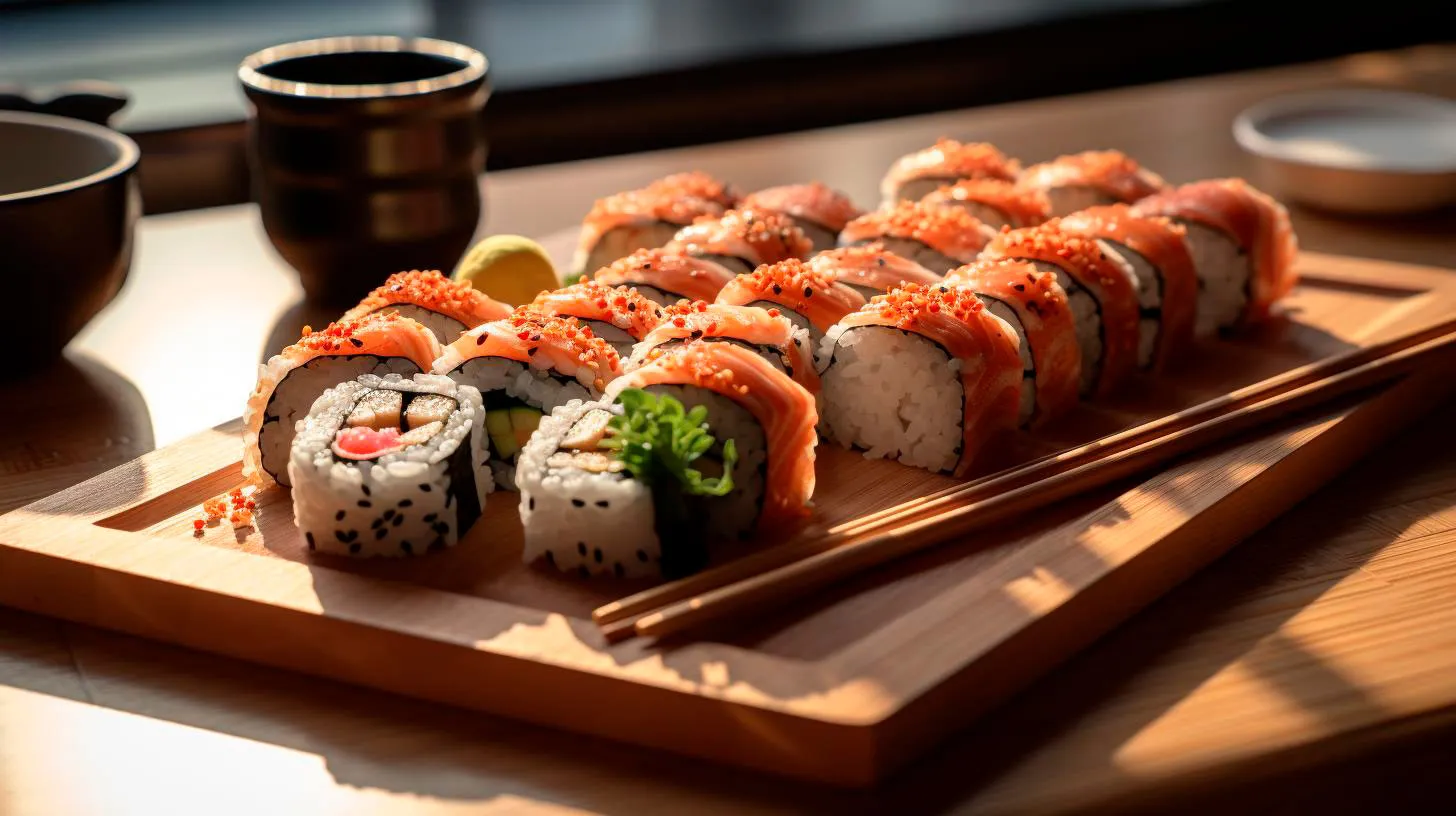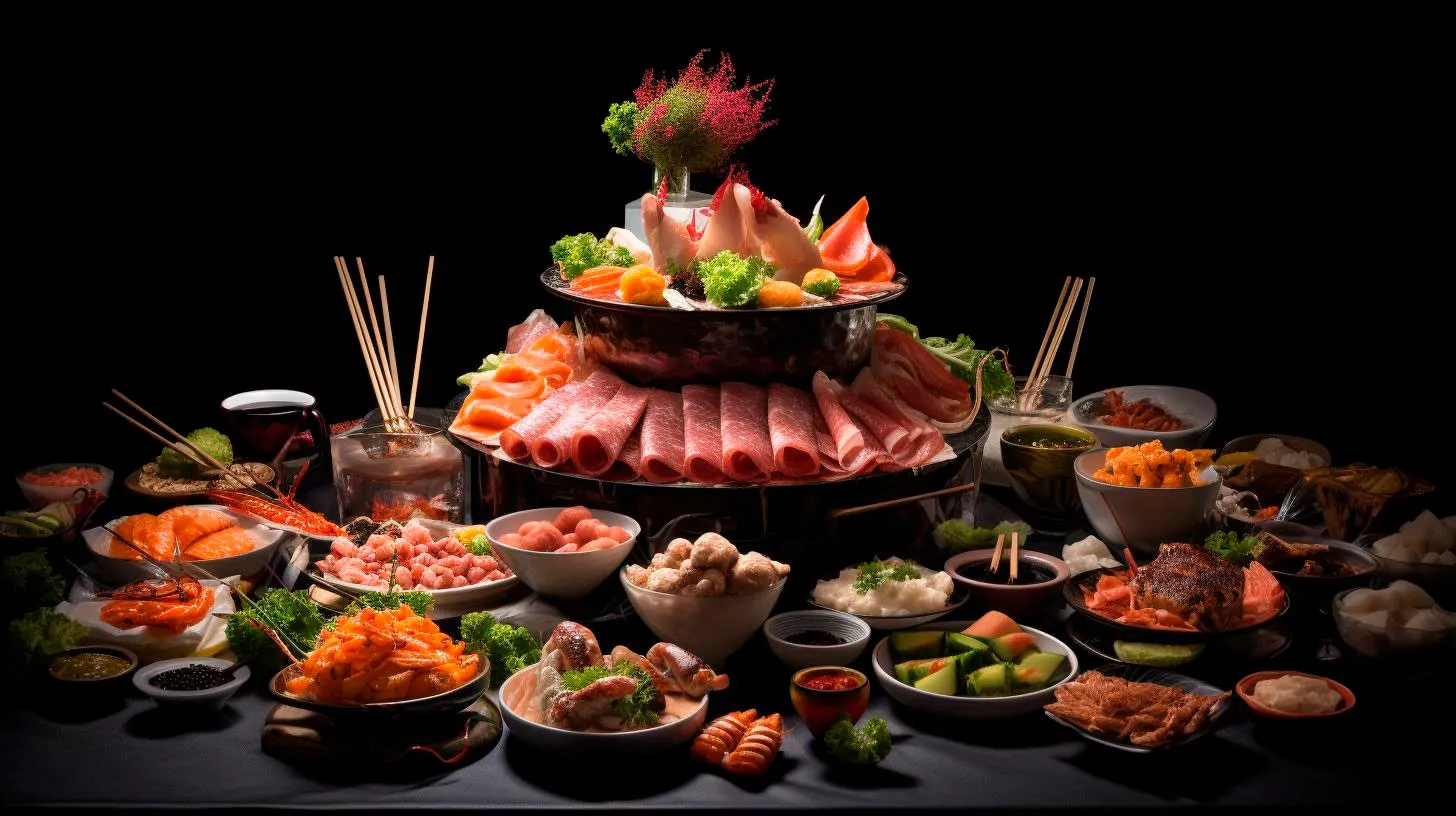Mastering Nigiri Sushi Rice: Understanding the Ideal Vinegar Ratio
One of the key factors that determine the taste and texture of nigiri sushi is the vinegar ratio used in making the rice. In this article, we will delve into the art of mastering nigiri sushi rice by understanding the ideal vinegar ratio.
The Importance of Vinegar in Nigiri Sushi Rice
Vinegar plays a crucial role in nigiri sushi rice as it adds a distinct tangy flavor while ensuring that the rice grains stick together without becoming mushy. The right balance of vinegar can elevate the taste of the entire sushi dish, making it a delightful culinary experience.
When it comes to the ideal vinegar ratio for sushi rice, it typically ranges between 4 to 6 tablespoons of vinegar for every 2 cups of cooked sushi rice. However, the exact ratio may vary depending on personal preference and the type of vinegar used.
Factors to Consider for the Ideal Vinegar Ratio
While there are general guidelines for the vinegar ratio in nigiri sushi rice, several factors come into play when determining the perfect balance. Here are some key considerations:
- Type of Vinegar: There are different types of vinegar that can be used in sushi rice, such as rice vinegar, white vinegar, or a combination of both. Each type has its own distinct flavor profile, so it’s important to choose the one that complements the overall taste of your sushi.
- Sweetness: Some sushi chefs prefer to add a touch of sweetness by incorporating sugar or mirin (sweet rice wine) into the vinegar mixture. This balances the tanginess and enhances the flavor of the rice.
- Seasoning: Apart from vinegar, salt is often added to the rice to enhance the overall taste. The appropriate amount of salt can significantly impact the flavor of the sushi rice, so it’s essential to find the right balance.
Mastering the ideal vinegar ratio requires practice, experimentation, and keen attention to detail. Adjustments can be made to create a unique flavor that suits your taste preferences and the types of ingredients you plan to use for your nigiri sushi.
The Perfect Texture: Achieving the Right Vinegar Ratio
Striking a balance between a tender yet firm texture in the sushi rice is vital for the overall nigiri sushi experience. Here are some tips to achieve the perfect texture by using the ideal vinegar ratio:
- Vinegar Distribution: Ensure that the cooked rice is evenly coated with the vinegar mixture. Gently folding the rice with a wooden spatula or rice paddle helps distribute the vinegar while keeping the grains intact.
- Cooling Time: After adding the vinegar mixture to the rice, let it cool naturally to allow the flavors to meld together and for the rice to reach the desired texture. Hastening the cooling process by using a fan or a flat tray can produce inconsistent results.
- Moisture Level: The sushi rice should be moist and sticky, but not overly wet. Adjusting the vinegar ratio can help achieve the perfect moisture level, ensuring that the grains stick together without clumping.
Key Takeaways
Mastering the ideal vinegar ratio for nigiri sushi rice opens a world of flavorful possibilities. Here are the key takeaways:
- Vinegar enhances flavor: The right amount of vinegar adds a tangy taste that complements the sushi rice and brings out the flavors of the accompanying ingredients.
- Experiment with vinegar types: Rice vinegar and white vinegar offer different flavor profiles, allowing you to customize the taste of your sushi rice.
- Consider sweetness and seasoning: Incorporating sugar, mirin, or salt can balance the flavors and make the sushi rice more enjoyable.
- Texture matters: Achieving a tender yet firm texture in the rice is crucial for a satisfying nigiri sushi experience.
- Practice and experimentation: Finding the ideal vinegar ratio takes practice and experimentation to create a unique flavor that suits your palate.
By understanding the importance of vinegar, considering factors that influence the ideal vinegar ratio, and mastering the right texture, you can elevate your nigiri sushi to a whole new level. So, roll up your sleeves, grab some fresh ingredients, and embark on a journey to create nigiri sushi that delights your taste buds!
Unlocking the Secrets of the Perfect Vinegar Balance in Nigiri Sushi Rice
In this article, we will explore the secrets behind achieving the ideal vinegar balance and how it can elevate your sushi-making skills to new heights.
The Importance of Vinegar in Sushi Rice
Vinegar plays a vital role in sushi rice by adding flavor, enhancing texture, and prolonging the shelf life of the rice. Traditionally, sushi rice is seasoned with a combination of rice vinegar, sugar, and salt. These ingredients work together to create a delicate balance that complements the other elements in nigiri sushi.
Understanding the perfect vinegar balance is crucial for sushi chefs and enthusiasts alike. It is a delicate dance between the subtle acidity of the vinegar and the sweetness of the sugar. Achieving this balance will help you create sushi rice that is flavorful, moist, and firm enough to hold its shape when forming nigiri.
The Secrets Behind the Perfect Vinegar Balance
While achieving the perfect vinegar balance may seem intimidating, it is a skill that can be mastered with practice and attention to detail. Here are some secrets to help you unlock the secrets of the perfect vinegar balance:
- Quality Rice Vinegar: Start with a high-quality rice vinegar that has a mild flavor and balanced acidity. Look for brands that are specifically labeled for sushi rice.
- Correct Ratios: The ideal vinegar balance is a matter of personal taste, but a standard starting point is approximately 3 tablespoons of vinegar for every 2 cups of cooked rice. Adjust the ratio according to your preference.
- Balance of Sweetness: Achieving the right amount of sweetness is crucial. Add sugar gradually, tasting as you go, until you find the perfect balance that complements the vinegar acidity.
- Consistency Is Key: To ensure an even distribution of vinegar throughout the rice, gently fold the vinegar mixture into the cooked rice using a cutting motion. Avoid stirring vigorously, as this can make the rice mushy.
Advantages of the Perfect Vinegar Balance
The benefits of achieving the perfect vinegar balance in nigiri sushi rice are numerous. Here are some advantages that come with mastering this skill:
- Enhanced Flavor: The interplay between the acidity of the vinegar and the sweetness of the sugar enhances the overall umami flavor of the sushi rice, making each bite truly delectable.
- Improved Texture: The vinegar also helps create a moist and yet firm texture in the rice, allowing it to hold its shape when forming nigiri. This is essential for sushi that not only tastes great but looks visually appealing.
- Extended Shelf Life: The vinegar acts as a natural preservative, helping to extend the shelf life of the sushi rice without compromising its taste or texture.
Key Takeaways
Unlocking the secrets of the perfect vinegar balance in nigiri sushi rice is a skill worth mastering for any sushi enthusiast. By using high-quality rice vinegar, achieving the correct ratios of vinegar, sugar, and salt, and ensuring an even distribution, you can elevate your sushi-making skills to new heights. The advantages of achieving the perfect vinegar balance include enhanced flavor, improved texture, and extended shelf life for your delicious creations.
Remember, practice makes perfect, and with time, you will be able to master the art of achieving the ideal vinegar balance in nigiri sushi rice. So, roll up your sleeves, experiment in the kitchen, and enjoy the delightful journey of creating sushi that is both delicious and visually stunning.
The Science Behind Vinegar in Nigiri Sushi Rice
And at the heart of this science is the use of vinegar.
Traditionally, nigiri sushi rice is prepared by mixing rice with rice vinegar, sugar, and salt. This combination creates a unique flavor profile and texture that complements the fish and other toppings. But what is it about vinegar that makes it so essential in sushi rice?
The Importance of Vinegar in Sushi Rice
There are several reasons why vinegar plays a crucial role in the preparation of nigiri sushi rice:
- Flavor: The acidic nature of vinegar adds a tangy taste to the rice, which helps balance out the richness of the fish and other ingredients. It gives sushi rice its distinct, refreshing flavor that keeps you craving for more.
- Preservation: Vinegar has natural antimicrobial properties, which help preserve the sushi rice and prevent the growth of bacteria. In the past, when refrigeration was not widely available, vinegar was used as a natural preservative to keep the rice fresh.
- Texture: The vinegar in sushi rice helps break down the starches and makes the grains slightly sticky. This stickiness is crucial for holding the rice together when shaping it into nigiri or rolls. It also enhances the textural experience of sushi, making it easier to eat with chopsticks.
- Tradition and Culture: Vinegar has been used in sushi rice for centuries in Japan. It is deeply ingrained in the culinary traditions and cultural heritage of the country. The use of vinegar in sushi rice is a nod to the history and authenticity of this iconic Japanese dish.
The Science Behind the Vinegar
When rice vinegar is added to cooked rice, a chemical reaction called ‘acid hydrolysis’ takes place. During this reaction, the vinegar breaks down the starch molecules in the rice. The breakdown of starch leads to the release of sugars, which adds sweetness to the rice. This is why sushi rice has a slightly sweet taste that complements the savory ingredients it is paired with.
Acid hydrolysis also creates a gel-like texture in the rice. The broken-down starch molecules absorb water and form a sticky matrix, giving sushi rice its characteristic texture. The stickiness of the rice ensures that it holds its shape when formed into nigiri or rolled into sushi rolls.
Additionally, the vinegar’s acidity acts as a natural preservative. By lowering the pH level of the rice, vinegar creates an environment that hinders the growth of harmful bacteria. This serves as a crucial safety measure, ensuring that the sushi rice remains safe for consumption.
Key Takeaways
Understanding the science behind vinegar in nigiri sushi rice adds a new dimension to our appreciation of this culinary craft. Here are the key takeaways:
- Sushi rice is enhanced by the addition of vinegar, which contributes to its flavor, texture, and preservation.
- Vinegar breaks down starches in the rice, creating sweetness and a gel-like texture.
- The stickiness of sushi rice helps it hold its shape when formed into nigiri or rolls.
- Vinegar acts as a natural preservative, inhibiting the growth of harmful bacteria in the rice.
- The use of vinegar in sushi rice is deeply rooted in Japanese tradition and culture.
In conclusion, the science behind vinegar in nigiri sushi rice is an integral part of the sushi-making process. The unique combination of flavors, textures, and preservation techniques makes sushi rice a key component of this beloved Japanese dish. So, the next time you indulge in a plate of nigiri sushi, take a moment to appreciate the science that goes into every grain of rice.
Exploring the Crucial Role of Vinegar in Achieving Nigiri Sushi Rice Perfection
In this article, we will delve into the significant role of vinegar in achieving nigiri sushi rice perfection.
The Tradition of Sushi Rice
Sushi rice, also known as “shari,” is the foundation of all sushi. It is the delicate balance of textures and flavors that makes a nigiri sushi roll exquisite. The tradition of using vinegar in sushi rice can be traced back centuries in Japan.
Vinegar was initially used as a method of food preservation, but over time, it became an essential ingredient in sushi rice. The acidity of vinegar not only enhances the taste but also helps prevent food poisoning by inhibiting the growth of bacteria. Today, sushi chefs take great care in selecting the perfect vinegar to elevate the quality of their sushi rice.
The Role of Vinegar in Sushi Rice
Vinegar serves several crucial purposes in the preparation of sushi rice. Let’s explore some of its key functions:
- Flavoring: Vinegar adds a tangy and slightly sweet taste to the sushi rice, complementing the other ingredients in the roll. It gives a distinct umami flavor that awakens the taste buds.
- Texture: Vinegar helps in achieving the perfect texture of sushi rice. It breaks down the starches in the rice, making it sticky and firm, allowing the grains to hold together when formed into nigiri or rolled into sushi rolls.
- Preservation: Vinegar acts as a natural preservative, extending the shelf life of the sushi rice. It helps inhibit the growth of harmful bacteria and ensures the safety of the sushi.
By using the correct variety and proportion of vinegar, sushi chefs can create the ideal balance between flavor, texture, and safety in their sushi rice.
Choosing the Right Vinegar
The choice of vinegar plays a vital role in the overall quality of sushi rice. Traditionally, sushi rice is made using rice vinegar, which has a mild and delicate taste. However, other types of vinegar, such as apple cider vinegar or white wine vinegar, can be used based on personal preference.
When selecting vinegar for sushi rice, it is crucial to consider the acidity level. The ideal vinegar should have around 4-6% acidity to balance with the sweetness of the rice. It is recommended to avoid highly acidic vinegars that may overpower the flavor of the rice.
Key Takeaways
Understanding the importance of vinegar in achieving nigiri sushi rice perfection can elevate your sushi-making skills. Here are the key takeaways:
- Vinegar imparts flavor and enhances the taste of sushi rice.
- The texture of sushi rice is greatly improved by vinegar, making it sticky and firm.
- Vinegar acts as a natural preservative, extending the shelf life of sushi rice.
- The choice of vinegar is crucial, with rice vinegar being the traditional and preferred option.
- Opt for vinegar with a moderate acidity level to balance the overall flavors.
Next time you enjoy a piece of nigiri sushi, appreciate the meticulous effort and attention to detail that goes into achieving the perfect sushi rice. Vinegar is one of the unsung heroes in the art of sushi-making, transforming a humble grain into a culinary masterpiece.



